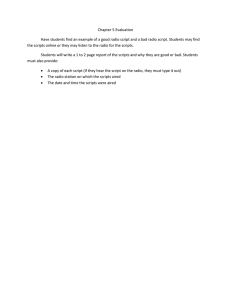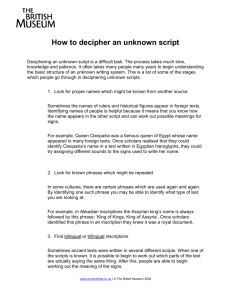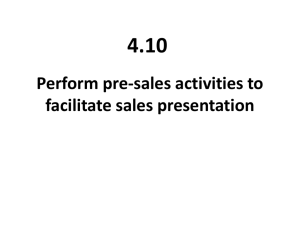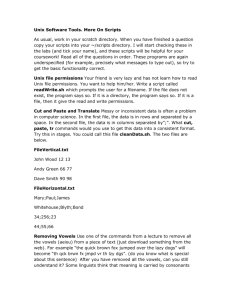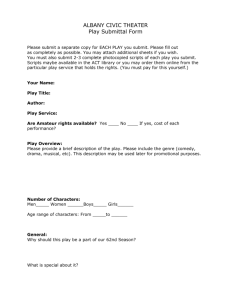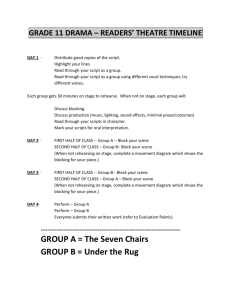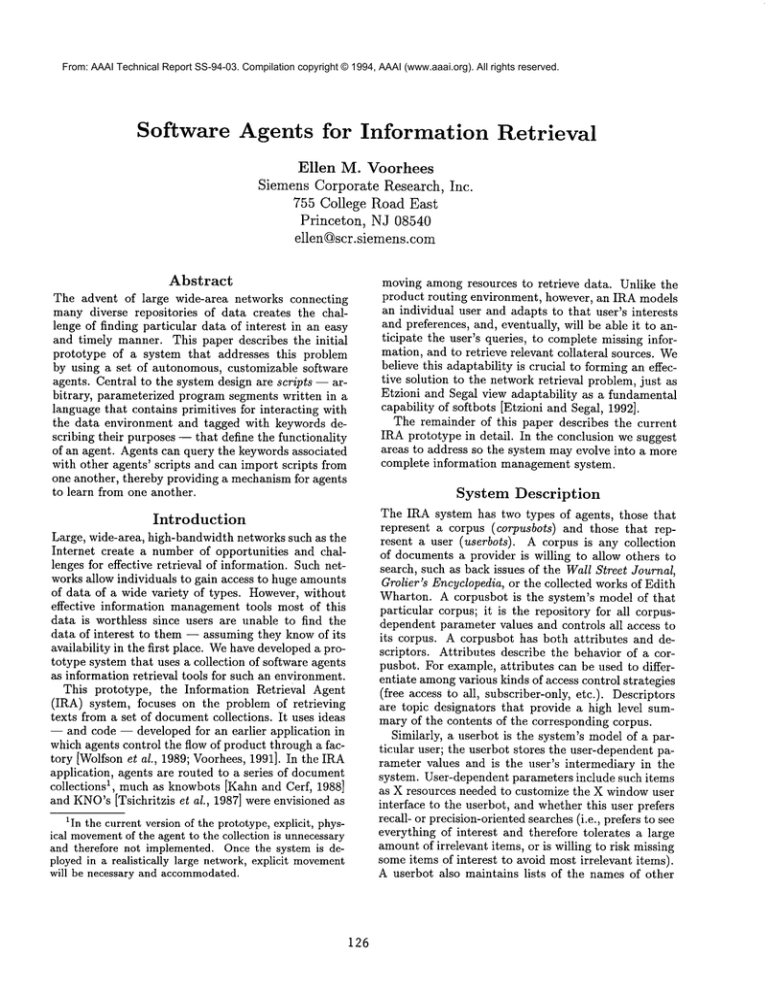
From: AAAI Technical Report SS-94-03. Compilation copyright © 1994, AAAI (www.aaai.org). All rights reserved.
Software
Agents for Information
Retrieval
Ellen M. Voorhees
Siemens Corporate Research, Inc.
755 College Road East
Princeton, NJ 08540
ellen~scr.siemens.com
Abstract
The advent of large wide-area networks connecting
many diverse repositories of data creates the challenge of finding particular data of interest in an easy
and timely manner. This paper describes the initial
prototype of a system that addresses this problem
by using a set of autonomous, customizable software
agents. Central to the system design are scripts -- arbitrary, parameterized program segments written in a
language that contains primitives for interacting with
the data environment and tagged with keywords describing their purposes -- that define the functionality
of an agent. Agents can query the keywords associated
with other agents’ scripts and can import scripts from
one another, thereby providing a mechanismfor agents
to learn from one another.
Introduction
Large, wide-area, high-bandwidth networks such as the
Internet create a number of opportunities and challenges for effective retrieval of information. Such networks allow individuals to gain access to huge amounts
of data of a wide variety of types. However, without
effective information managementtools most of this
data is worthless since users are unable to find the
data of interest to them -- assuming they knowof its
availability in the first place. Wehave developed a prototype system that uses a collection of software agents
as information retrieval tools for such an environment.
This prototype, the Information Retrieval Agent
(IRA) system, focuses on the problem of retrieving
texts from a set of documentcollections. It uses ideas
-- and code -- developed for an earlier application in
which agents control the flow of product through a factory [Wolfsonet al., 1989; Voorhees, 1991]. In the IRA
application, agents are routed to a series of document
collections 1, much as knowbots [Kahn and Cerf, 1988]
and KNO’s[Tsichritzis et al., 1987] were envisioned as
1In the current version of the prototype, explicit, physical movement
of the agent to the collection is unnecessary
and therefore not implemented. Once the system is deployed in a realistically large network, explicit movement
will be necessary and accommodated.
126
moving among resources to retrieve data. Unlike the
product routing environment, however, an IRA models
an individual user and adapts to that user’s interests
and preferences, and, eventually, will be able it to anticipate the user’s queries, to complete missing information, and to retrieve relevant collateral sources. We
believe this adaptability is crucial to forming an effective solution to the network retrieval problem, just as
Etzioni and Segal view adaptability as a fundamental
capability of softbots [Etzioni and Segal, 1992].
The remainder of this paper describes the current
IRAprototype in detail. In the conclusion we suggest
areas to address so the system may evolve into a more
complete information management system.
System Description
The IRA system has two types of agents, those that
represent a corpus (corpusbots) and those that represent a user (userbots). A corpus is any collection
of documents a provider is willing to allow others to
search, such as back issues of the Wall Street Journal,
Grolier’s Encyclopedia, or the collected works of Edith
Wharton. A corpusbot is the system’s model of that
particular corpus; it is the repository for all corpusdependent parameter values and controls all access to
its corpus. A corpusbot has both attributes and descriptors. Attributes describe the behavior of a corpusbot. For example, attributes can be used to differentiate amongvarious kinds of access control strategies
(free access to all, subscriber-only, etc.). Descriptors
are topic designators that provide a high level summary of the contents of the corresponding corpus.
Similarly, a userbot is the system’s model of a particular user; the userbot stores the user-dependent parameter values and is the user’s intermediary in the
system. User-dependent parameters include such items
as X resources needed to customize the X windowuser
interface to the userbot, and whether this user prefers
recall- or precision-oriented searches (i.e., prefers to see
everything of interest and therefore tolerates a large
amountof irrelevant items, or is willing to risk missing
some items of interest to avoid most irrelevant items).
A userbot also maintains lists of the names of other
userbots and corpusbots knownto its user. In addition,
a userbot contains a list of specialties. Like descriptors,
specialties are topic designators, but in this case, the
topics are presumed to be areas in which its user has
interest and expertise. Specialties are arbitrary strings
self-selected by the user, e.g., "information retrieval",
"UNIXsystem kernel hacks", "hang gliding".
An agent is implementedas a long-lived process that
reacts to typed messages sent to it by someagent (including possibly itself). Messagesare processed in the
order in which they are received and may cause the
agent to perform some action. Whenthere are no messages to process, the agent simply waits for another
message to be received. An agent may send a message
to any agent whose name it knows; it may also send
a message to either the entire set of corpusbots or the
entire set of userbots.
The ability to send a message to all corpusbots
greatly facilitates resource discovery -- a userbot need
simply announce its request on a given topic and see
which corpusbots respond. However, sending a single
message to all corpusbots in a large, wide-area network
is clearly infeasible. The IRA system can scale up to
such a network by interpreting "all" as "all the agents
in the local domain". The ISIS distributed toolkit [Isis
Distributed Systems, Inc., 1992], which we use as our
communication medium, provides support for domaindependent communication. Explicit movement among
domainsas described in [Wolfsonet al., 1989] will allow
userbots to find resources not within their immediate
vicinity of the network.
Userbots
Userbots are the primary component of the IRA prototype system. Userbots send and receive messages
among themselves and also send messages to corpusbots. A userbot responds to some basic messages such
as requests for the contents of its specialty list or names
of the corpora and users it knows. However, the bulk
of a userbot’s functionality is defined by the scripts
it knows. Scripts are arbitrary, parameterized subprograms written in a language that contains primitives for interacting in the IRAenvironment, standard
flow control and data manipulation statements, and
the ability to execute a commandat the operating system level (i.e., a function akin to C’s "system" call).
Scripts have keywords assigned to them that describe
the overall objective of the script.
Figure 1 gives a (stylized) exampleof a script. This
script’s intended purpose is to search databases that
are known to contain sports information for sports
stories;
it might thus be tagged with the keyword
"sports". The function calls in boldface are IRAenvironment primitives. Someprimitives send messages to
agents and make the replies available in the data space
of the script. For example, select_corpora_desc(x)
sends a message to the userbot itself asking for the
list of knowncorpora that have the descriptor x, and
127
q = "baseball football hockey basketball lacrosse";
corpora = select-corpora_desc("sports");
if (size(corpora) == 0)
announce_failure("No sports databases.");
some = 0;
for each namei in corpora do {
results = query(namei,q,15);
if (size(results) > O)
display _results (results);
some++;
}
}
if (some == 0)
announce_failure("No
sports news today.");
Figure 1: A script designed to retrieve sports articles.
query( db, query-text, num-wanted) submits a query
to db’s corpusbot. Other primitives provide access to
the data thus returned (e.g., size) or handle I/0 with
the user interface program (e.g., dlsplay_results and
announce_failure).
A separate user-interface program allows a user and
his or her userbot to interact with one another. When
invoked, the user interface program displays icons representing the set of corpora and users that are knownto
the userbot, and the list of scripts the userbot knows.
Clicking on an icon causes the information associated
with that particular entity to be presented. For example, the information associated with a corpus includes
its attributes, its descriptors, and a history of its retrieval effectiveness (measured in terms of recall and
precision). Selecting a script from the lists of scripts
invokes that script. Oncea script is invoked, the userbot interprets the associated program code and creates
a complete execution trace (including parameter values; actions performed; results of individual actions,
if any; errors encountered; etc.). This trace is currently used to showthe path the userbot takes through
the data space on the user’s display. In the future it
can be used as the episodic memory from which the
userbot can refine its model of the user and thereby
improve its effectiveness [Stanfill and Waltz, 1986;
Maes and Kozierok, 1993].
A userbot is initialized with a default set of scripts.
This set includes scripts that allow the user to send
and receive messages for all the userbots’ basic message types: search for databases that have particular
attributes or descriptors, search for users that have
particular specialties, and submit a query to a particular database. Non-null results of the first two scripts
are included in the userbot’s list of knowncorpora or
knownusers. Default scripts also exist for searching
the keywords associated with another (known) user’s
scripts, importing another user’s script into one’s own
userbot, and incorporating newly-authored scripts into
the userbot.
The ability to incorporate new scripts into a userbot
is a powerful method through which users can extend
and customize the functionality of their userbots. Series of search commandsthat are frequently repeated
(such as an early-morning search for the previous day’s
sports scores) can be codified in a script; the entire sequence can then be invoked in a single command.Furthermore, since the scripts maycontain other arbitrary
program segments, the same script can manipulate the
retrieved data however the user desires.
Importing scripts from other users makes customization even easier. Suppose, for example, that Alan
is looking for documents about a new tax law, but
doesn’t know where to look. He knows, however that
Barbara is a tax-specialist (or, he queries the local
domain to see if there are any users with "taxes" or
"tax attorney" as a specialty), so he searches Barbara’s
scripts for one tagged with "taxes" as a keyword. Assuming he finds one, he can import it and use it to
submit his tax question, thereby immediately benefiting from Barbara’s experience with tax databases. Of
course, users maynot desire others to be able to see
certain scripts, and the prototype allows users to mark
scripts as private. Still, there are a vast number of
other privacy and security concerns in a system such
as this that the prototype does not address.
Since all of a user’s interaction with the IRA system occurs through his or her userbot, the userbot has
the potential to become an expert on its user. Longstanding interests of the user can be used to form interest profiles that can be refined with relevance data using filtering techniques [Belkin and Croft, 1992]. Further, the userbot can build user-dependent models of
the utility of particular corpora (e.g., this user almost
always finds articles from the Wall Street Journal relevant, but seldom likes articles from the Federal Register). The effectiveness data currently stored in the
known corpora list is a rudimentary form of such a
model.
Corpusbots
Corpusbots are fairly pedestrian in the current prototype. A corpusbot sends no messages and responds to
exactly four message types:
¯ a request for its attributes receives the attribute list
in reply;
¯ a request for its descriptors receives the descriptor
list in reply;
¯ a message containing a natural language query and a
numberof documentsto be retrieved receives a list of
that many[document id, document title, similarity
value] triples in reply; and
¯ a message containing a list of document ids receives
the texts of those documentsin reply.
Both retrieving documents in response to a query and
fetching text given a document id are implemented using the SMART
information retrieval system [Salton
and McGill, 1983].
Just as a userbot may becomean expert on its user,
a corpusbot is the single access point to its corpus,
and thus it has the potential to become an expert on
the corpus. The corpusbot is the logical repository
for relevance data across all users of the corpus. It
can then use this data to improve its indexing of the
corpus using, for example, the technique suggested by
Fuhr and Buckley [Fuhr and Buckley, 1991].
Conclusion
We have developed a prototype system that uses
software agents to retrieve documents from disparate
databases. As a prototype, the system has somelimitations in both implementation and design. The current
implementation does not permit concurrent execution
of scripts in a single userbot, nor does it allow one
script to call another. As a consequence, userbots remain idle unless a user is actively engaged with the
system. More fundamentally, these agents do not yet
have the initiative and adaptability required for a truly
adequate solution to the network retrieval problem.
Nevertheless, the IRA system has several interesting
features. The direct transfer of ideas and code from the
product routing application to the network retrieval
application demonstrates that agents as user-written
programs are applicable in multiple problem domains.
The prototype as it exists today can automate routine
retrieval
tasks, and can accommodate some measure
of resource discovery by capitalizing on others’ experience. At the very least, the use of one script by many
different individuals leverages the cost of writing the
script. Finally, the prototype provides a test-bed for
continued research into developing more sophisticated
agents.
One of the more important ways we hope to increase
the sophistication of the agents is in their ability to
model their users and corpora. As suggested above,
relevance information from the users should be able
to be exploited so that the agents’ models evolve over
time in such a way as overall effectiveness is improved.
References
Nicholas J. Belkin and W. Bruce Croft. Information
filtering and information retrieval: Twosides of the
same coin? Communications of the ACM, 35(12):2938, December 1992.
Oren Etzioni and Richard Segal. Softbots as testbeds
for machine learning. In Working Notes of the 1992
Spring Symposium on Knowledge Assimilation, pages
43-50. American Association for Artificial Intelligence, March 1992.
Norbert Fuhr and Chris Buckley. A probabilistic
learning
approach for document indexing.
ACM
128
Transactions on Information Systems, 9(3):223-248,
July 1991.
Isis Distributed Systems, Inc. Isis Distributed Toolkit
Version 3.0 User Guide and Reference Manual.
Ithaca, NY, 1992.
Robert E. Kahn and Vinton G. Cerf. The Digital
Library Project Volume 1: The world of knowbots
(DRAFT).Corporation for National Research Initiatives, March1988.
Pattie Maes and Robyn Kozierok. Learning interface
agents. In Proceedings of the Eleventh National Conference on AI (AAAI-93). American Association for
Artificial Intelligence, July 1993.
G. Salton and M. J. McGill. Introduction to Modern
Information Retrieval. McGraw-Hill, NewYork, 1983.
Craig Stanfill
and David Waltz. Toward memorybased reasoning.
Communications of the ACM,
29(12):1213-1228, December 1986.
D. Tsichritzis, E. Fiume, S. Gibbs, and O. Nierstrasz.
KNOs: KNowledge acquisition,
dissemination,
and
manipulation Objects. ACMTransactions on Office
Information Systems, 5(1):96-112, 1987.
Ellen M. Voorhees. Using computerized routers to
control product flow. In Proceedings of the 24th Annual Hawaii International Conference on System Sciences (HICSS-24), volume 2, pages 275-282, January
1991.
C. Daniel Wolfson, Ellen M. Voorhees, and Maura M.
Flatley. Intelligent routers. In Proceedings of the
Ninth International Conference on Distributed Computing Systems, pages 371-376. IEEE, June 1989.
129

